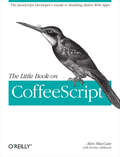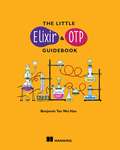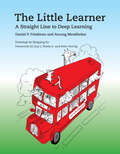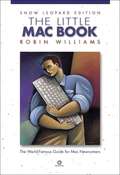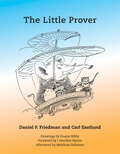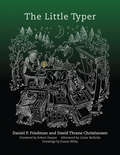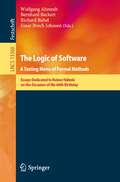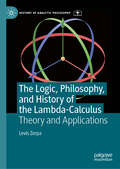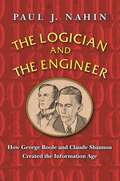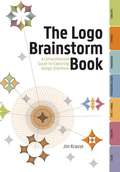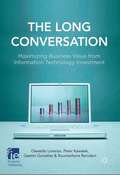- Table View
- List View
The Little Book on CoffeeScript: The JavaScript Developer's Guide to Building Better Web Apps
by Alex MacCawThis concise book shows JavaScript developers how to build superb web applications with CoffeeScript, the remarkable language that’s gaining considerable interest. Through example code, this guide demonstrates how CoffeeScript abstracts JavaScript, providing syntactical sugar and preventing many common errors. You’ll learn CoffeeScript’s syntax and idioms step by step, from basic variables and functions to complex comprehensions and classes.Written by Alex MacCaw, author of JavaScript Web Applications (O’Reilly), with contributions from CoffeeScript creator Jeremy Ashkenas, this book quickly teaches you best practices for using this language—not just on the client side, but for server-side applications as well. It’s time to take a ride with the little language that could.Discover how CoffeeScript’s syntax differs from JavaScriptLearn about features such as array comprehensions, destructuring assignments, and classesExplore CoffeeScript idioms and compare them to their JavaScript counterpartsCompile CoffeeScript files in static sites with the Cake build systemUse CommonJS modules to structure and deploy CoffeeScript client-side applicationsExamine JavaScript’s bad parts—including features CoffeeScript was able to fix
The Little Database: A Poetics of Media Formats (Electronic Mediations #64)
by Daniel Scott SnelsonA poetics for reading the everyday objects that populate a hard drive Bespoke online archives like PennSound and Eclipse host an astounding array of &“old media&” artifacts, posing a handcrafted counterpoint to the immense databases aggregated by digital titans like Google and Facebook. In The Little Database, Daniel Scott Snelson argues for the significance of these comparatively &“small&” collections, exploring how digital archives dramatically transform the artifacts they host and how they might help us better understand our own private collections in turn. Examining curated collections such as Textz, UbuWeb, and the Electronic Poetry Center, Snelson explores media-specific works by poets and artists, including William Carlos Williams, Tracie Morris, bill bissett, Nam June Paik, and Vicki Bennett. He develops creative tools and contingent methods for reading cultural data, whether found on the internet or in our own collections of TXT, JPG, MP3, and MOV artifacts, presenting case studies to show how these objects have come to find revised meaning in their digital contexts. Along the way, experimental poetic interludes give readers practical entry points into the creative practice of producing new meanings in any given little database. Inventive and interdisciplinary, The Little Database grapples with the digitized afterlives of cultural objects, showing how the past is continually reconfigured to shape the present. It invites readers to find playful and personal means for unpacking their own data collections, in the process discovering idiosyncratic ways to explore and connect with digital archives. Retail e-book files for this title are screen-reader friendly with images accompanied by short alt text and/or extended descriptions.
The Little Elixir & OTP Guidebook
by Benjamin Tan Wei HaoSummaryThe Little Elixir & OTP Guidebook gets you started programming applications with Elixir and OTP. You begin with a quick overview of the Elixir language syntax, along with just enough functional programming to use it effectively. Then, you'll dive straight into OTP and learn how it helps you build scalable, fault-tolerant and distributed applications through several fun examples. Purchase of the print book includes a free eBook in PDF, Kindle, and ePub formats from Manning Publications.About the TechnologyElixir is an elegant programming language that combines the expressiveness of Ruby with the concurrency and fault-tolerance of Erlang. It makes full use of Erlang's BEAM VM and OTP library, so you get two decades' worth of maturity and reliability right out of the gate. Elixir's support for functional programming makes it perfect for modern event-driven applications.About the BookThe Little Elixir & OTP Guidebook gets you started writing applications with Elixir and OTP. You'll begin with the immediately comfortable Elixir language syntax, along with just enough functional programming to use it effectively. Then, you'll dive straight into several lighthearted examples that teach you to take advantage of the incredible functionality built into the OTP library. What's InsideCovers Elixir 1.2 and 1.3Introduction to functional concurrency with actorsExperience the awesome power of Erlang and OTP About the ReaderWritten for readers comfortable with a standard programming language like Ruby, Java, or Python. FP experience is helpful but not required. About the AuthorBenjamin Tan Wei Hao is a software engineer at Pivotal Labs, Singapore. He is also an author, a speaker, and an early adopter of Elixir.Table of ContentsGETTING STARTED WITH ELIXIR AND OTPIntroduction A whirlwind tour Processes 101 Writing server applications with GenServer FAULT TOLERANCE, SUPERVISION, AND DISTRIBUTION Concurrent error-handling and fault tolerance with links, monitors, and processes Fault tolerance with Supervisors Completing the worker-pool application Distribution and load balancing Distribution and fault tolerance Dialyzer and type specifications Property-based and concurrency testing
The Little Learner: A Straight Line to Deep Learning
by Daniel P. Friedman Anurag MendhekarA highly accessible, step-by-step introduction to deep learning, written in an engaging, question-and-answer style.The Little Learner introduces deep learning from the bottom up, inviting students to learn by doing. With the characteristic humor and Socratic approach of classroom favorites The Little Schemer and The Little Typer, this kindred text explains the workings of deep neural networks by constructing them incrementally from first principles using little programs that build on one another. Starting from scratch, the reader is led through a complete implementation of a substantial application: a recognizer for noisy Morse code signals. Example-driven and highly accessible, The Little Learner covers all of the concepts necessary to develop an intuitive understanding of the workings of deep neural networks, including tensors, extended operators, gradient descent algorithms, artificial neurons, dense networks, convolutional networks, residual networks, and automatic differentiation. Conversational style, illustrations, and question-and-answer format make deep learning accessible and funIncremental approach constructs advanced concepts from first principlesPresents key ideas of machine learning using a small, manageable subset of the Scheme languageSuitable for anyone with knowledge of high school math and some programming experience
The Little MLer
by Matthias Felleisen Daniel P. FriedmanOver the past few years, ML has emerged as one of the most important members of the family of programming languages. Many professors in the United States and other countries use ML to teach courses on the principles of programming and on programming languages. In addition, ML has emerged as a natural language for software engineering courses because it provides the most sophisticated and expressive module system currently available. Felleisen and Friedman are well known for gently introducing readers to difficult ideas. The Little MLer is an introduction to thinking about programming and the ML programming language. The authors introduce those new to programming, as well as those experienced in other programming languages, to the principles of types, computation, and program construction. Most important, they help the reader to think recursively with types about programs.
The Little Mac Book, Snow Leopard Edition
by Robin WilliamsAdopting a back-to-the-basics approach, this bestselling little Mac classic has been revised and overhauled to introduce users to Snow Leopard, Apple's newest version of its operating system. In the gentle, friendly, funny style that generations of computer users have come to know and love, author Robin Williams shows readers how to dive in and start working with the Mac and OS X Snow Leopard. This little book walks readers through all of the key new features in Snow Leopard. Using straightforward, jargon-free explanations delivered in logical, easy-to-follow sections, Robin is a new user's personal guide, coaching and encouraging readers as they learn their way around the magic of the Mac.
The Little Prover
by Daniel P. Friedman Carl EastlundAn introduction to writing proofs about computer programs, written in an accessible question-and-answer style, complete with step-by-step examples and a simple proof assistant.The Little Prover introduces inductive proofs as a way to determine facts about computer programs. It is written in an approachable, engaging style of question-and-answer, with the characteristic humor of The Little Schemer (fourth edition, MIT Press). Sometimes the best way to learn something is to sit down and do it; the book takes readers through step-by-step examples showing how to write inductive proofs. The Little Prover assumes only knowledge of recursive programs and lists (as presented in the first three chapters of The Little Schemer) and uses only a few terms beyond what novice programmers already know. The book comes with a simple proof assistant to help readers work through the book and complete solutions to every example.
The Little Typer
by Daniel P. Friedman David Thrane ChristiansenAn introduction to dependent types, demonstrating the most beautiful aspects, one step at a time.A program's type describes its behavior. Dependent types are a first-class part of a language, and are much more powerful than other kinds of types; using just one language for types and programs allows program descriptions to be as powerful as the programs they describe. The Little Typer explains dependent types, beginning with a very small language that looks very much like Scheme and extending it to cover both programming with dependent types and using dependent types for mathematical reasoning. Readers should be familiar with the basics of a Lisp-like programming language, as presented in the first four chapters of The Little Schemer. The first five chapters of The Little Typer provide the needed tools to understand dependent types; the remaining chapters use these tools to build a bridge between mathematics and programming. Readers will learn that tools they know from programming—pairs, lists, functions, and recursion—can also capture patterns of reasoning. The Little Typer does not attempt to teach either practical programming skills or a fully rigorous approach to types. Instead, it demonstrates the most beautiful aspects as simply as possible, one step at a time.
The Logic of Connective Action
by W. Lance Bennett Alexandra SegerbergThe Logic of Connective Action explains the rise of a personalized digitally networked politics in which diverse individuals address the common problems of our times such as economic fairness and climate change. Rich case studies from the United States, United Kingdom, and Germany illustrate a theoretical framework for understanding how large-scale connective action is coordinated using inclusive discourses such as "We Are the 99%" that travel easily through social media. In many of these mobilizations, communication operates as an organizational process that may replace or supplement familiar forms of collective action based on organizational resource mobilization, leadership, and collective action framing. In some cases, connective action emerges from crowds that shun leaders, as when Occupy protesters created media networks to channel resources and create loose ties among dispersed physical groups. In other cases, conventional political organizations deploy personalized communication logics to enable large-scale engagement with a variety of political causes. The Logic of Connective Action shows how power is organized in communication-based networks, and what political outcomes may result.
The Logic of Responsibility Voids (Synthese Library #456)
by Hein DuijfThis book focuses on the problem of responsibility voids: these are cases where responsibility for a morally undesirable outcome cannot be attributed to any of the involved agents. Responsibility voids are thought to occur in collective decision-making and in the context of artificial intelligent systems. In these cases, philosophers worry that there is a shortfall of moral responsibility. In particular, such voids are often assumed to justify a notion of collective responsibility that cannot be reduced to individual responsibility. One of the aims of the book is to study how collective responsibility and joint action relate to individual responsibility and individual actions. The book offers a unifying framework for modelling moral responsibility by drawing from modal logic and game theory.The book investigates the possibility and scope of the problem of responsibility voids. One of its characteristics is its pluralistic perspective on moral responsibility: in contrast to giving a unique and all-encompassing definition of it, the book makes progress by spelling out and modelling several conceptions of moral responsibility. One of the appealing features of the book is that a relatively small range of models is used to investigate a variety of conceptions of moral responsibility. The unifying framework can thus be used to characterize the conditions under which responsibility voids are ruled out.
The Logic of Software. A Tasting Menu of Formal Methods: Essays Dedicated to Reiner Hähnle on the Occasion of His 60th Birthday (Lecture Notes in Computer Science #13360)
by Einar Broch Johnsen Wolfgang Ahrendt Bernhard Beckert Richard BubelThis Festschrift, dedicated to Reiner Hähnle on the occasion of his 60th birthday, contains papers written by many of his closest collaborators.After positions at Karlsruhe Institute of Technology and Chalmers University of Technology, since 2011 Reiner has been the chaired professor of Software Engineering at Technische Universität Darmstadt, where his team focuses on the formal verification of object-oriented software, the formal modeling and specification of highly adaptive software systems, and formal modeling and analysis in domains such as biological systems and railroad operations. His work is characterized by achievements in theory and in practical implementations, significant collaborations include the KeY project and the development of the ABS language. He has served as chair and editor of important related academic conferences, and coauthored almost 200 academic publications. The contributions in this volume reflect Reiner’s main research focus: formal methods, in particular applied to software verification.
The Logic, Philosophy, and History of the Lambda-Calculus: Theory and Applications (History of Analytic Philosophy)
by Levis ZerpaThis is the first book focused on the logico-philosophical aspects of the lambda-calculus since the inception of the field in 1932 in the pioneering work of Alonzo Church. The book starts a new field called “lambda-philosophy”: a branch of logic-based analytic philosophy in the tradition of Frege and Russell, directly constructed from the lambda-calculus. Another innovation of the book is a new graphical and intuitive logico-mathematical notation for the lambda-calculus called “the container notation”. The book covers in detail some episodes of the history of the subject, including three comparative studies of the lambda-calculus with Viète's algebra, Descartes' analytic geometry, and Wittgenstein’s Tractatus. A didactic approach to the logico-mathematical aspects of the lambda-calculus, partially based on cognitive science, provides the technical basis for the analysis. In this way, the book provides a systematic and coherent treatment of diverse logico-philosophical aspects and applications of the lambda-calculus as part of the platform offered by lambda-philosophy. The book includes the following: a detailed treatment of the ambiguities of the concept of function (under the traditional or Euler’s notation); an elucidation of the notion of transformative philosophical analysis; an account of Church’s methodology which shows that the lambda-calculus is an adequate solution to the problem of a philosophical analysis of functions as rules of computation; a didactic treatment of the formal aspects of the lambda-calculus through the container notation; and diverse arithmetical and logical examples of the container notation. The book questions a dogma of algorithmic thinking by arguing that the lambda-calculus is more intuitive and natural than Turing machines. The Logic, Philosophy, and History of the Lambda-Calculus is essential reading for all scholars and researchers of the history of analytic philosophy and especially those focussing on logic-based analytic philosophy.
The Logician and the Engineer: How George Boole and Claude Shannon Created the Information Age
by Paul J. NahinHow two pioneers of math and technology ushered in the computer revolutionBoolean algebra, also called Boolean logic, is at the heart of the electronic circuitry in everything we use—from our computers and cars, to home appliances. How did a system of mathematics established in the Victorian era become the basis for such incredible technological achievements a century later? In The Logician and the Engineer, Paul Nahin combines engaging problems and a colorful historical narrative to tell the remarkable story of how two men in different eras—mathematician and philosopher George Boole and electrical engineer and pioneering information theorist Claude Shannon—advanced Boolean logic and became founding fathers of the electronic communications age. Nahin takes readers from fundamental concepts to a deeper and more sophisticated understanding of modern digital machines, in order to explore computing and its possible limitations in the twenty-first century and beyond.
The Logo Brainstorm Book: A Comprehensive Guide for Exploring Design Directions
by Jim KrauseDon't Wait for Inspiration to StrikeWhether you're facing a new logo project or you've reached a block in your current work, The Logo Brainstorm Book will inspire you to consider fresh creative approaches that will spark appealing, functional and enduring design solutions.Award-winning designer Jim Krause (author of the popular Index series) offers a smart, systemic exploration of different kinds of logos and logo elements, including:SymbolsMonogramsTypographic LogosType and Symbol CombinationsEmblemsColor Palettes Through a combination of original, visual idea-starters and boundary-pushing exercises, The Logo Brainstorm Book will help you develop raw logo concepts into presentation-ready material.
The Long Conversation
by Oswaldo LorenzoFor many years companies have been investing in enterprise systems and IT initiatives butthey are now struggling to achieve the desired results. It takes a long time to make the best of your enterprise systems so businesses must stop looking for the next technology 'silver bullet' and instead maximize the value of existing IT investments. "
The Long Evolution of Brains and Minds
by Gerhard RothThe main topic of the book is a reconstruction of the evolution of nervous systems and brains as well as of mental-cognitive abilities, in short "intelligence" from simplest organisms to humans. It investigates to which extent the two are correlated. One central topic is the alleged uniqueness of the human brain and human intelligence and mind. It is discussed which neural features make certain animals and humans intelligent and creative: Is it absolute or relative brain size or the size of "intelligence centers" inside the brains, the number of nerve cells inside the brain in total or in such "intelligence centers" decisive for the degree of intelligence, of mind and eventually consciousness? And which are the driving forces behind these processes? Finally, it is asked what all this means for the classical problem of mind-brain relationship and for a naturalistic theory of mind.
The Long Game: Inside Sinn Féin
by Aoife MooreInside the rise of the political party, once subordinate to the IRA, that is on the brink of taking power in Ireland Sinn Féin, long widely-regarded as the political wing of the Provisional IRA, is the most popular political party in both Northern Ireland and the Republic. A movement once synonymous with a paramilitary campaign is on the brink of taking real power through purely democratic means. But if Sinn Féin has mastered the art of electoral politics, it remains strangely opaque. Who really runs the party? How is it funded? And what can we expect of it as a party of government?Aoife Moore, Irish Journalist of the Year 2021. explores these and other burning questions in The Long Game. Drawing on exclusive interviews with current and former members of Sinn Féin, she builds up a picture of a party undergoing a profound, and still incomplete, transformation. She looks at the key individuals and moments that put the party on its present course, and she explores tensions within the party and the wider republican movement.Packed with revelatory details, The Long Game is a groundbreaking telling of contemporary Ireland's biggest and most elusive political story.
The Long Tail: Why the Future of Business is Selling Less of More
by Chris AndersonAnderson shows how the future of commerce and culture isn't in the high-volume head of a demand curve but in the endlessly long tail of that same curve.
The Loop: How Technology Is Creating a World Without Choices and How to Fight Back
by Jacob WardThis eye-opening narrative journey into the rapidly changing world of artificial intelligence reveals the dangerous ways AI is exploiting the unconscious habits of our minds, and the real threat it poses to humanity: "The best book I have ever read about AI" (New York Times bestselling author Roger McNamee). Artificial intelligence is going to change the world as we know it. But the real danger isn't some robot that's going to enslave us: It's our own brain. Our brains are constantly making decisions using shortcuts, biases, and hidden processes—and we're using those same techniques to create technology that makes choices for us. In The Loop, award-winning science journalist Jacob Ward reveals how we are poised to build all of our worst instincts into our AIs, creating a narrow loop where each generation has fewer, predetermined, and even dangerous choices. Taking us on a world tour of the ongoing, real-world experiment of artificial intelligence, The Loop illuminates the dangers of writing dangerous human habits into our machines. From a biometric surveillance state in India that tracks the movements of over a billion people, to a social media control system in China that punishes deviant friendships, to the risky multiple-choice simplicity of automated military action, Ward travels the world speaking with top experts confronting the perils of their research. Each stop reveals how the most obvious patterns in our behavior—patterns an algorithm will use to make decisions about what's best for us—are not the ones we want to perpetuate. Just as politics, marketing, and finance have all exploited the weaknesses of our human programming, artificial intelligence is poised to use the patterns of our lives to manipulate us. The Loop is call to look at ourselves more clearly—our most creative ideas, our most destructive impulses, the ways we help and hurt one another-so we can put only the best parts of ourselves into the thinking machines we create.
The Lost Blogs: From Jesus to Jim Morrison
by Paul DavidsonThere are over 13 million people in the world currently blogging, but what about the blogs written by the iconic men and women who (unfortunately) died before the Internet was even invented? In this witty and original take on the most important technological development since spam, THE LOST BLOGS offers hundreds of blogs from the most famous minds in history, detailing their hysterically personal (and impersonal) revelations, such asJohn Lennons thoughts after meeting a young woman named Yoko Ono (and her strange interest in the Beatles publishing rights)Tips of the trade from Jesus Christs carpentry blog, including how to build a combination water and wine rackShakespeares treatment for a new play about two princes who misplace their horse and carriage and spend the entire play trying to locate itHow a stray hot dog nearly derailed Ghandis hunger strikeJim Morrisons original lyrics to Light My Fire (what does smell like a burning tire?)And the missing two cents from everyone else who matters, proving theres no such thing as too much information.
The Low Light Photography Field Guide: Go Beyond Daylight To Capture Stunning Low Light Images (Field Guide Ser.)
by Michael FreemanLike all the titles in this successful series, The Low Light Photography Field Guide offers advice from a respected expert and professional. In this volume, Michael Freeman looks at an area that remains problematic for photographers with even top-of-the range equipment: low light.Opening with a section on the qualities of different kinds of low light, the book then deals with ways of overcoming gloomy situations, whether you're shooting hand-held or on a tripod. Post-production fixes are also covered, allowing the reader to turn difficult shots into amazing images.
The Low-Code AI Maturity Model: Leading Responsible AI Transformation with Microsoft Power Platform
by Steve JefferyWritten from the perspective of an experienced IT expert, this book leverages a maturity model framework to guide organizations through each stage of adopting, securing, scaling, and tracking the value of low-code AI responsibly and efficiently. Unlike other works that focus only on AI&’s technical aspects, this book boasts a practical roadmap for responsible AI adoption and provides a clear, structured maturity model that guides organizations from foundational steps to advanced, responsible AI practices. In a world where organizations are under pressure to innovate quickly and responsibly, this book provides a structured approach, addressing essential elements such as data management, governance, ethics and compliance in low-code AI environments. Each chapter represents a maturity level, from foundational to optimized, offering readers insights, practical steps and examples to support their journey. The Low-Code AI Maturity Model takes a comprehensive look into the transformative potential of low-code and AI. What You Will Learn Identify, assess and mitigate risks to ensure stable and reliable AI deployments Implement robust governance, aligning with compliance standards and ethical principles at each maturity stage Evaluate the real business value and ROI of AI projects, empowering data-driven decision-making Who This Book Is For <p class
The Low-Density University: 15 Scenarios for Higher Education
by Joshua Kim Edward J. MaloneyCOVID-19 has placed American higher education at a crossroads. This book is the roadmap.COVID-19 triggered an existential crisis for American higher education. Faced with few safe choices, most colleges and universities switched to remote learning during the 2020 spring semester. The future, however, provides more choices about how institutions can fulfill their mission of teaching and research. But how do we begin to make decisions in an uncertain and shifting environment? In this concise guide, authors Edward J. Maloney and Joshua Kim lay out clear ways colleges and universities can move forward in safe and effective ways.The Low-Density University presents fifteen scenarios for how colleges and universities can address the current crisis from a fully online semester to others with students in residence and in the classroom. How can changing the calendar or shifting to hybrid models of blended classrooms impact teaching, learning, and the college experience? Could we emerge from this crisis with new models that are better and more adapted to today's world? The Low-Density University focuses primarily on teaching and learning, but student life (housing, athletics, health, etc.) are core to the college experience. Can we devise safe and effective ways to preserve the best of that experience? The lessons here extend beyond the classroom. Just as the pandemic will change American higher education, the choices we make now will change what college looks like for generations to come.
The Ludotronics Game Design Methodology: From First Ideas to Spectacular Pitches and Proposals
by J. MartinThis book supports readers to transition to more advanced independent game projects by deepening their understanding of the concept development process. It covers how to make concepts sufficiently viable, ambitious, and innovative to warrant the creation of a polished prototype in preparation of a publisher pitch. The book is divided into six sections. After a brief tutorial (Preliminary Phase), readers embark on a journey along the book’s methodology. They travel through successive conceptual phases (Preparations, Procedures, Processes, and Propositions); advance through levels and action beats in each of these phases; master challenges (conceptual tasks) and overcome level bosses (design decisions) that become successively harder; collect items (fulfilled documentation tasks); and “win” the game by having progressed from a raw, initial idea to a full-fledged, polished game treatment. This book is designed to support junior and senior year BA or MA students in game design programs, as well as novice indie developers and those in the early stages of their game design career.
The MPEG Representation of Digital Media
by Leonardo ChiariglioneMore and more information, audio and video but also a range of other information type, is generated, processed and used by machines today, even though the end user may be a human. The result over the past 15 years has been a substantial increase in the type of information and change in the way humans generate, classify, store, search, access and consume information. Conversion of information to digital form is a prerequisite for this enhanced machine role, but must be done having in mind requirements such as compactness, fidelity, interpretability etc. This book presents new ways of dealing with digital information and new types of digital information underpinning the evolution of society and business.
